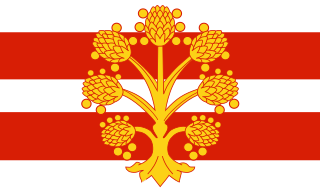
Cumbria is a ceremonial county in North West England. It borders the Scottish council areas of Dumfries and Galloway and Scottish Borders to the north, Northumberland and County Durham to the east, North Yorkshire to the south-east, Lancashire to the south, and the Irish Sea to the west. Its largest settlement is the city of Carlisle.

Sizergh Castle is a stately home with garden and estate at Helsington in Cumbria, England, about 4 miles (6 km) south of Kendal. Located in historic Westmorland, the castle is a Grade I listed building. While remaining the home of the Hornyold-Strickland family, the castle with its garden and estate is in the care of the National Trust.

Westmorland is an area of Northern England which was historically a county. People of the area are known as Westmerians. The area includes part of the Lake District and the southern Vale of Eden.

Kendal, once Kirkby in Kendal or Kirkby Kendal, is a market town and civil parish in the Westmorland and Furness district of Cumbria, England. It lies within the River Kent's dale, from which its name is derived, just outside the boundary of the Lake District National Park.

Appleby-in-Westmorland is a market town and civil parish in Westmorland and Furness, Cumbria, England, with a population of 3,048 at the 2011 Census. Crossed by the River Eden, Appleby is the county town of the historic county of Westmorland. It was known just as Appleby until 1974–1976, when the council of the successor parish to the borough changed it to retain the name Westmorland, which was abolished as an administrative area under the Local Government Act 1972, before being revived as Westmorland and Furness in 2023. It lies 14 miles (23 km) south-east of Penrith, 32 miles (51 km) south-east of Carlisle, 27 miles (43 km) north-east of Kendal and 45 miles (72 km) west of Darlington.

Penrith is a market town and civil parish in the Westmorland and Furness district of Cumbria, England. It is less than 3 miles (5 km) outside the Lake District National Park and about 17 miles (27 km) south of Carlisle. It is between the Rivers Petteril and Eamont and just north of the River Lowther. The town had a population of 15,181 at the 2011 census. It is part of historic Cumberland.
Delaney is an Irish surname derived from the Gaelic Ó Dubhshláine, Dubh meaning black and Sláine for the River Sláine (Slaney). DeLaney is also of Norman origin. Variants include Delaney, Delany and Dulaney.
Kirkby is a northern English name of Scandinavian origin, meaning "church town". It may refer to:

The Barony of Kendal is a subdivision of the English historic county of Westmorland. It evolved from one of two ancient baronies that make up the county, the other being the Barony of Westmorland. In 1974, the entire county became part of the modern county of Cumbria and ceased to have an administrative function. At the same time, Kendal borough along with some other rural and urban districts in Westmorland was merged with the neighbouring parts of Lancashire, Furness and Cartmel, and also the Sedbergh Rural District of the West Riding of Yorkshire into the new South Lakeland district of the new county.
Braithwaite, Brathwaite, or Brathwait is an English surname of Old Norse origin. At the time of the British Census of 1881, the relative frequency of the surname Braithwaite was highest in Westmorland, followed by Cumberland, Yorkshire, Linlithgowshire, Lancashire, County Durham, Nottinghamshire, Leicestershire, Anglesey and Flintshire. Notable people with the surname include:
Westmorland in North West England was abolished in 1974 following Ted Heath's Local Government Act 1972. Westmorland became a part of Cumbria along with Cumberland, parts of Yorkshire and Lancashire, including the Furness peninsular. In 2022 Westmorland was reconstituted as Westmorland and Furness following the abolition of Cumbria County Council. Westmorland and Furness have no High Sheriff as Cumbria has remained the ceremonial county.

Sir Thomas de Strickland was an English soldier. He is best known for carrying the banner of St. George at the battle of Agincourt.
John Weston may refer to:
Sir Robert Strickland of Sizergh was an English landowner and politician who sat in the House of Commons in the Parliament of 1624. He supported King Charles I during the Wars of the Three Kingdoms.
The surname Kendall, Kendl, or Kendal has two widely accepted origins. The first is from the market town of Kendal in Cumbria. The earliest recorded form of this town's name is in 1095 as Kircabikendala, literally "Church by Kent dale". The second is as an anglicization of Middle Welsh Kyndelw, a given name, as in Cynddelw Brydydd Mawr.
Edge is a surname of Anglo-Saxon or Norse origin. Notable people with the surname include:
Pope is a Scottish surname meaning "father".
Elmore is a given name and surname of English origin. The name is identified as a habitational name derived from the place name, Elmore in Gloucestershire, named from Old English elm 'elm' + fer 'river bank' or ofer 'ridge'".









